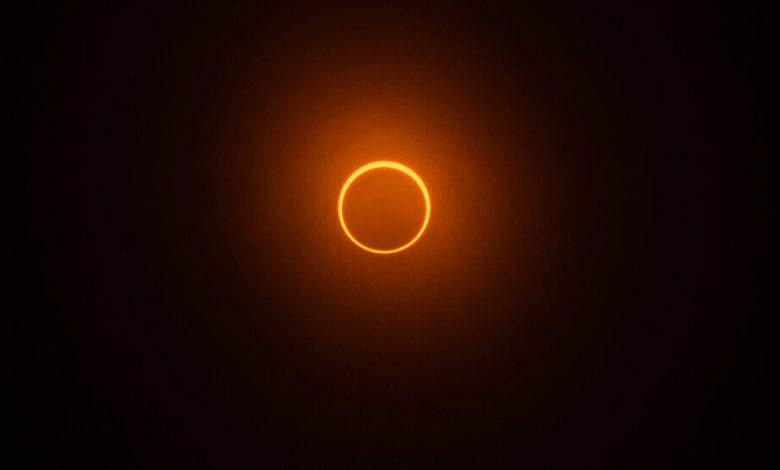A Solar Eclipse Leaves Its Mark Across a Hemisphere

A trail of darkness swept across the Western Hemisphere on Saturday, starting at the Oregon coast and then venturing to the southwest as it cut through Nevada, Utah, New Mexico, Texas and other states. It was an annular solar eclipse that millions of people across the United States and Latin American countries experienced as a ring of fire in their local skies.
The path of annularity, or the path where the moon was most centered over the sun, was about 130 miles wide. People traveled from great distances to reach this shadowy strip, soaking up the four to five minutes of the darkest phase for those who got closer to its center.
“You see a picture, and it just doesn’t do it justice,” said Matthew Neal, who drove to Richfield, Utah, from San Diego with his wife, Jennifer Neal, to chase the eclipse.
Millions more people experienced a partial solar eclipse, with considerable dimming of the sun occurring in major cities like Seattle, Los Angeles, Houston, Mexico City and Bogotá, even though they were far outside the path of annularity in some cases.
Here are photos from the path of the eclipse.
United States
Crowds began gathering as early as 4 a.m. in Chaco Culture National Historical Park in New Mexico. Some of them had been planning the trip for over a year.
“I don’t know if there is a better place to see the rich cultural connection between humanity and the cosmos,” said Mike Shaw, an astrophotographer who traveled from St. Paul, Minn.

Eclipse watchers began gathering as early as 4 a.m. in Chaco Culture National Historical Park in New Mexico on Saturday.Credit…Nina Riggio for The New York Times
Photographers finding a vantage point in Chaco Canyon.
An eclipse watcher stood at sunrise in Bryce Canyon National Park in Utah.
A view of the moon from Albuquerque as it began to cross into the path of the sun.
Watching the eclipse in San Antonio.




Credit…Kaylee Greenlee for The New York Times
“This is really cool,” said Easton Galindo, 11, a fifth grader who wants to grow up to be an astrophysicist. He added, referring to a forthcoming total eclipse on April 8, 2024, that will also cross San Antonio: “Today we have an annular eclipse and then in a few months a total one. We’re just so lucky.”
The ring of fire as seen from Chaco Canyon.
Paul Casanova Garcia, 71, waited for the solar eclipse at Mission San José in San Antonio.
“The most exciting part is the rings of fire,” said Mr. Garcia, who is member of the San Antonio Mission Indian Descendants group. “The eclipses are really important and spiritual for Native American people.”
Spectators in Corpus Christi, Texas, watched in awe of the “ring of fire” phase of the solar eclipse.

CreditCredit…Reuters
Colombia
The view from above, as observers gathered at the Colombian National University at Palmira to wait for the event.
One observer perfecting the view from below.
Adding a solar filter to the body of a telescope in Palmira. Eclipse watchers used an incredible range of devices to view the event, from homemade viewers to high-end cameras and telescopes.
The eclipse in view in Palmira.
Mexico
People gathering to observe the eclipse from the Edzná Archaeological Zone in Campeche.
Adair Rico, 38 of Campeche, said he brought his 7-year-old son, Andre Rico, to Edzná “to go back to our roots, to our pre-Hispanic roots that we, the Mexican, have to Mayan, Aztec people.”
As the crowd began to exit the area, Mr. Rico looked down from the top of one ruin and said he was glad so many tourists came.
“The Yucatán Peninsula is an open book of history for people all over the world,” he said.
Staring at the sky at the National Polytechnic Institute in Mexico City.
The moon crossing in front of the sun, as seen in Mexico City.
Katrina Miller contributed reporting from Richfield, Utah; Dave Philipps from Chaco Canyon, N.M.; Edgar Sandoval from San Antonio; and Zolan Kanno-Youngs from Edzná, Mexico.




